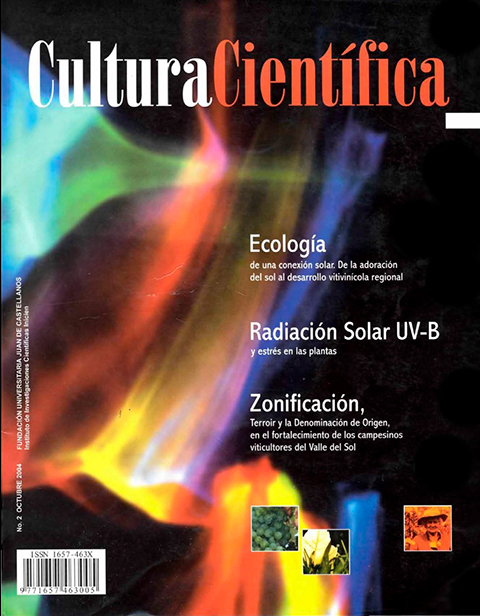Abstract
Ptants are in charge of essential metabolic processes. They have the responsibility of generating oxygen and nutritious compounds through photosynthesis, starting from water, dioxide of carbon and solar energy. Therefore, they are essential to maintain life on earth. The place they are developed becomes the source of information to determine the quantity and quality of the crop. The light is heterogeneous and changing, therefore they are exposed to radiations unfavourable to its metabolic processes. Thus they have developed a series of structural and physiologic adaptations which allow them to Support and to take advantage of the available radiation. The ultraviolet solar energy is inhibitor and it can cause some biosynthetic unbalances which in turn, through secondary metabolism routs, can generate especial properties instilling typology in those types produced in tropical cold climates, with regional characteristics or with Denomination of Origin. The secondary biosynthesis is usually restricted to specific phases of plant development and to stress situations. Such conditions induce to the expression of genes that code several enzyme in the biosynthetic route of fenilpropanoid compounds.
Downloads
References
ARAKAWA, 0. 1993. Effect of ultraviolet light on anthocyaninh synthesis in light-colored sweet cherry, cv. Sata Nishiki. Journal of the Japanese Society for Horticultural Science. 62(3): 543-546.
BLANKE, M. 1996. Transmissio of UV irradiance in to nectarine fruit. Angew botany. 70: 76•77
BORNMAN, J. 1999. localization and functional significance of flavonoids and related compounds. Rozena. J. Stratospheric ozone depletion: the effects of enchanced UV-B radiation on terrestrial ecosystems. Netherlands: backhuys publishers. 59-69.
CALDWELL, M. 1998; Effects of increased solar ultraviolet radiation of terrestrial ecosystems. Journal of photochemistry and photobiology. 46 (41-52).
CALDWELL, M.; BALLARE, C.; BORMAN, J; FLINT, S.; BJORN, L.; TERAMURA, A; KULANDAYVELU, G.; TEVINI, M. 2003. Terrestrial ecosystems, increased solar ultraviolet radiation and interactions whith other climatic change factors. Photochemistry Photobiology Science 12: 29-38.
CASAL, D. 2000. La luz como factor regulador del crecimiento. Elementos de fisiología vegetal. Azcón-Bieto, J. y Talón M. Mc Graw Hill. Barcelona, 377-388.
CHAPARRO, G. 2001. Asimilación carbónica de la vid (Vitis vinifera L.) en condiciones de altitud tropical. Alta irradiancia UV-B. Tesis Biología, Bogotá. Universidad Nacional de Colombia, 89p.
FREGONI, C. Y PEZZUITO. S. 2000. Principes el premiéres approaches de l'indice bioclimatique de qualite de fregoni. progrés agricole et viticole 117(18): 390-396.
FROHNMEYER, H. AND STAIGER, D,. 2003. Upgrade in the answers slight ultraviolet b. protection radiation half fillet ultraviolet b in plant. Damages and protection that balance. Plant Physiology. 133: 1420-1428.
HAHLBROCK, K. AND SCHEEL, D. 1989. Physiology and molecular biology of phenyl propanoid metabolism. Annu Rev plant Physiology plant molecular biology. 40: 347-369.
HAPP, HI. 1999. Indices for exploring the relationship between temperature and grape and wine flavor, Winw Industry Journal. 4(68-75).
JACKSON, D. Y LOMBARD, P. 1993. Environmental and management practices affecting grape composition and wine quality a review. American Journal enology viticulture. 44: 409-430.
JANSEN, M.; GABA, V. AND GREENBERG, B. 1998. Higher plants an UVB radiation: balancing damage, repair and acclimation. Trends plant science. 3:131-135.
MARTINEZ, F.; MONTE, E. Y RUIZ F. 2002. Fitocromos y desarrollo vegetal. Investigación y ciencia. 1: 20-29.
MORA, A. PARRA, L. Y QUIJANO RICO, M. 1999. Efectos de la radiación ultravioleta b solar sobre mildeo polvoso en vides de la variedad Ehrenfelser. Trabajo seleccionado por la OIV para el 24 congreso mundial del vino, Mainz.
PALAZON, J., CUSIDÓ, R. M., Y MORALES, C. 2002. Metabotismo y significación biológica de los polifenoles del vino. ACE de enología. 22-26.
PINOL, M.; PALAZON, J. Y CUSIDO, R. 2000. lntroducción al metabolismo secundario. Elementos de fisiología vegetal Azcón-Bieto, J. y Talón M. Mc Graw Hill .Barcelona, 261-283.
PYLE, J. 1996. Global ozone depletion. P.J. Lumbsden, ed, plants and UVB responses to environmental chage. Cambridge University press. 3-12.
QUIJANO RICO, M. 1991. De la ecología de la vid a la biotecnología del vino en Punta larga, Boyacá. Actas del VIII congreso Colombiano de Química, Cali, 198-200.
_____, 1993. Viticultura y Enología en altitud en el trópico. Agrodesarrollo, Tunja. 4: 321-328.
______, 1999. Viticultura y Enología Tropicales en Altitud. Similitudes y diferencias con regiones templadas tradicionales. Trabajo seleccionado por la OIV para el 24 congreso mundial del vino, Mainz.
_____, 2001. los vinos del Valle del Sol. Nacimiento de la Viticultura y la Enología de clima tropical frio, Cultura científica, FUJC. Tunja. 5-11.
_____, 2003. la luz como factor de tipicidad y calidad en el "terroir" tropical de altitud. Conferencia. Seminario. Luz y Nutrición como factores de producción.
_____, 2004. Ecología de una conección solar. De la adoración del sol al desarrollo vitivinícola regional. Inédito.
SEARLES, P.; CALDWEEL, M. Y WINTER, K. 1995. The response of five tropical dicotyledon species to solar ulrraviolet-b radiation. American journal of botany. 7: 445-453.
TADEO, F. 2000. Fisiología de las plantas y estrés. Elementos de fisiología vegetal Azcon B y Talón, M. Mc Graw Hill. Madrid, 481-498.
VALLADARES, F. 2001. Luz y evolución vegetal. Investigación y cienc1a. 2: 73• 79.
XIONG, F. AND DAY, T. 2001. effect of solar ultraviolet radiation during spring time ozone depletion on photosynthesis and biomass production of antartic vascular Plants. Plant physiology. 125: 738-751.
ZARAITI, F. 1997. La radlación solar. Naturaleza y efectos de la radiación ultravioleta y la capa de ozono. Forno, R y Andrade, M. Instituto de investigaciones físicas. UMSA. Bolivia. 1-7.





